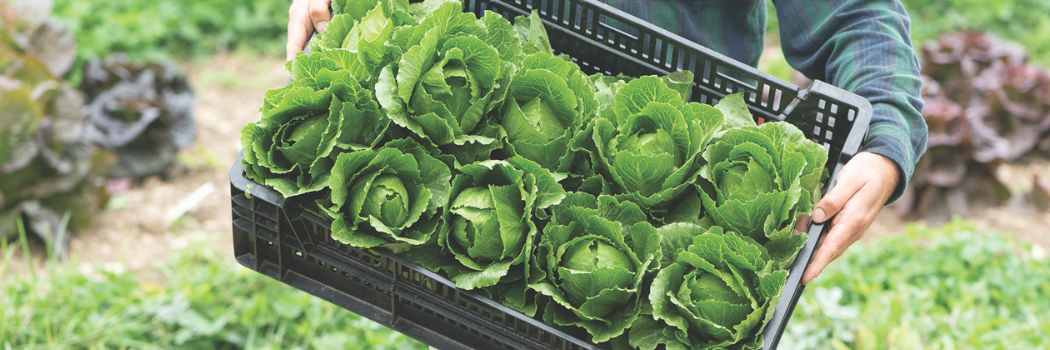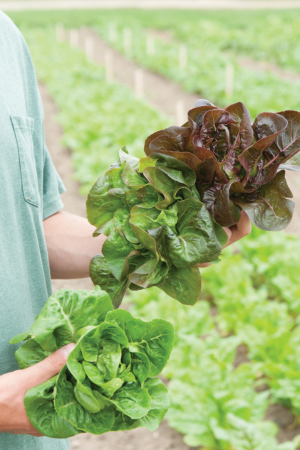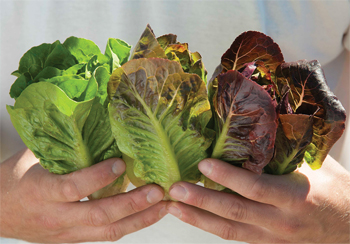- Baby Leaf Greens & Baby Leaf Lettuce | Technical Production Guide
- Growing Salad Gardens: An Ultimate Guide by Niki Jabbour | Johnny's Webinar Series
- Baby Leaf Lettuce | Variety Comparison Chart (PDF)
- Full-size Leaf Lettuce Varieties | Comparison Chart (PDF)
- Lettuce | Full-Head Varieties | Comparison Chart / Planting Program (PDF)
- Lettuce | Key Growing Information
- Lettuce Varieties | Quick-Reference Comparison Chart (PDF)
- Full-Size Romaine (Cos) Lettuce Varieties | Comparison Chart (PDF)
- Individual Salanova® Varieties | Comparison Chart (PDF)
- Salanova Lettuce | Tech Sheet (PDF)
- Growing Mini Versus Full-size Head Lettuce | A Look at the ROI
- Johnny's Planting & Harvesting Programs
- Pelleted Lettuce | Key Growing Information
- Salad Mixes & Microgreens Mixes | 2-pp Spec Sheet (PDF)
- Salanova Lettuce | Cutter Tool | Tech Sheet (PDF)
- Salanova Variety & Collection Specifications | 4-pp Brochure (PDF)
- Video: Baby Leaf Harvester for Greens, Mesclun, Spinach, Lettuces & Tender Aromatics
- Video: How to Grow Lettuce • From Seed to Harvest
- Video: Beat the Heat: Lettuce & Greens for Southern Growers | Johnny's Webinar Series
- Video: Salanova Lettuce | Growing, Preparing & Marketing
- Webinar Slide Deck | Lettuce & Greens for Southern Growers | PDF
- Baby Leaf Greens: 12 Picks for Market Growers | Johnny's Educational Webinar Resources
- Lettuce & Greens for Southern Growers | Johnny's Educational Webinar Resources
- Video: Baby Leaf Greens: 12 Picks for Market Growers | Johnny's Webinar Series
- Video: The Advantages of Salanova® Lettuce | Johnny's Selected Seeds
- Video: High-Value Crops & Varieties for Your Garden • Tutorial with Niki Jabbour
- Prismatic Mini-Head Lettuce Mix from Johnny's
- Webinar Slide Deck | One-Cut Lettuces: Insights & Techniques for Small Farms | 60-pp PDF
- Lettuce | Full Head Varieties | Succession Planting Program
- Video: One-Cut Lettuces: Insights & Techniques for Small Farms | Johnny's Webinar Series
- Growing Salad Gardens: An Ultimate Guide by Niki Jabbour | Johnny's Webinar Series
- One-Cut Lettuces | Johnny's Educational Webinar Resources
- 'Bigelow' Organic Mini-Head Lettuce Variety
- How to Choose & Grow the Best Lettuce | Tips for Every Grower
- Winter Growing Guide | Part 6: Recommended Crops & Varieties
- Kolibri: Mini-Head Bibb Lettuce Variety
Growing Mini Versus Full-Size Head Lettuce
Why It May Make Sense to Grow Some Minis
In addition to offering significant agronomic benefits, mini heads have the potential to be much more profitable than full-size heads, while still offering excellent flavor and shelf life.
In this article, we take a look at some of the advantages, key differences, and the return on investment between mini-head and full-size head lettuce, so you can decide whether mini-head lettuce is right for you.
Mini vs. Full-Size Head Lettuce
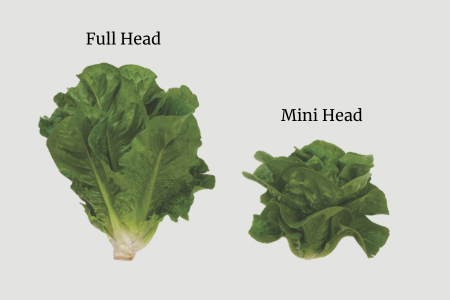
Size comparison of full head vs. mini head romaine lettuces. On the left is 'Salvius', a full-size romaine, and on the right, 'Dragoon', a mini-head romaine.
Full-Size Head Lettuce
Traditional, full-size heads have larger frames, and require more space to grow. They mature later and produce larger volumes of lettuce per head than mini heads.
Mini Head Lettuce
Single-serving, compact heads are planted at higher density and mature earlier, allowing for faster turnaround time to market. A 10' section of a 41 /2' bed can produce 180 mini heads versus 40 full-size heads.
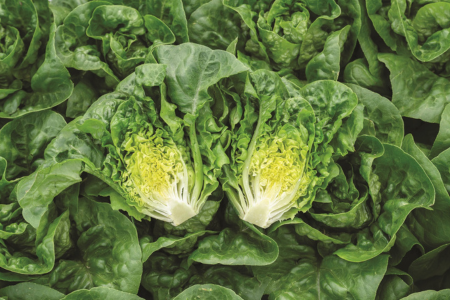
'Gatsbi' is an adaptable true mini lettuce with highly savoy green leaves and a gorgeous blanched heart.
True Minis
"True minis" are varieties with genetics that produce heads that are small at maturity. These varieties are bred to grow tight and upright, producing densely packed, diminutive leaves in a compact fashion, up off the ground.
One of the most popular true minis might be Little-Gem types. Horticulturally speaking, 'Little Gem' is an old-fashioned variety that is a cross between a Romaine and a Bibb. Newer varieties such as 'Newham' and 'Gatsbi' are improved "Little Gem" types. 'Rosaine' and 'Volcana' are red "Gem" types.
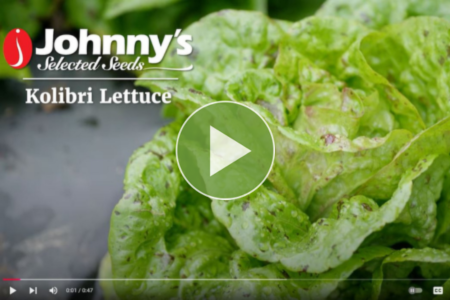
Watch our video about 'Kolibri', a fast maturing mini variety that holds extremely well in the field, and resists bolting.
Full-Size Varieties Grown as Minis
Minis can also be full-size head lettuce varieties that the grower harvests at a smaller, immature stage. Some full-size head lettuce varieties become dense early in their growing cycle and, if planted at relatively close spacing and harvested early, will produce quality, mini-sized heads. Prime examples include the following.
- Summer Crisp Varieties Suited to Mini Head Production:
- Multi-Leaf Varieties Suitable for Mini Head Production:
- Oakleaf Varieties Suited to Mini Head Production:

Watch our video about 'Prismatic Mini-Head Mix', an excellent choice for an effortlessly diverse and beautiful crop of mini-head one-cut lettuces.
Agronomical Advantages of Mini-Head Lettuce
Mini heads offer several agronomic advantages for the grower, largely because they are so fast to mature:
- They can be grown successfully in shorter seasonal slots, such as a late fall field planting or in tunnel plantings.
- They are a first-early option in spring plantings.
- They can be grown successfully in challenging weather/seasonal slots. For example, in summer they are more reliably heading and less likely than their full-size counterparts to experience tipburning before maturity.
View All Our Mini Bibbs…
View All Our Mini Romaines/Cos…
Running Some Numbers
Time & Space
Mini heads offer the grower the ability to produce a marketable crop in less space and less time than full heads. Here are some rough calculations. (You can plug in variables or estimates according to your own lettuce cultural practices and records.)
A 10' section of bed, 4½' wide, accommodates:
- 40 full-size heads at 12" spacing
- 180 mini heads at 6" spacing
For full-size heads, let's assume approximately 40 days to maturity from transplant, and for mini heads, 30 days to maturity from transplant.
Then, if the beds were initially planted on the same day, they would produce 3 crops of full-size lettuce, or 4 crops of mini head lettuce.
Thus, over a 120-day period one could grow:
- 120 full-size heads
- 720 mini heads
Gross Revenue and Return on Investment
If we assume the retail price of a mini-head is half that of a full-size head, given the production numbers above, the gross revenue for mini-heads would be about three times that of full-size heads for the same bed space.
Granted, you would have to start, transplant, and finish more flats of mini-lettuce for vs. full-size head lettuce, so factoring in materials and labor costs are an important consideration. But with numbers like this, it might make sense for you to develop your market for mini heads.
—Zaid Kurdieh, Norwich Meadows Farm, Norwich, New York
Marketing & Culinary Uses for Mini-Heads
Ideas for marketing include selling mini heads in colorful mixed boxes to chefs, or combining one red and one green mini in a bag to sell at farmers' markets. Consumers are increasingly attuned to the flavor, quality, and convenience of baby vegetables, and many will seek out single-serving heads.
As well as being perfectly sized for single-serve salads, some varieties of mini head lettuce are suitable for grilling, braising, and wilting. Their exquisite texture, flavor, and appearance make them a popular menu item at high-end restaurants, where they are often referred to as "Little Gem" lettuce.
As demand continues to grow, you may find that mini head lettuce can become an important crop for you. At minimum, mini head lettuces can nicely complement your head lettuce offerings, and help you branch into additional marketing channels.


